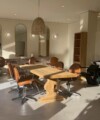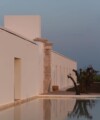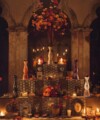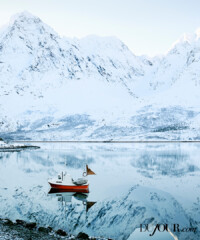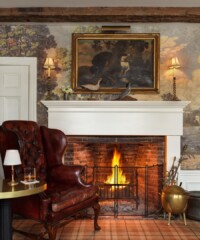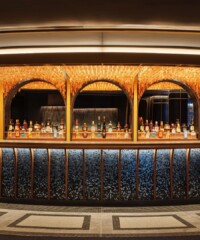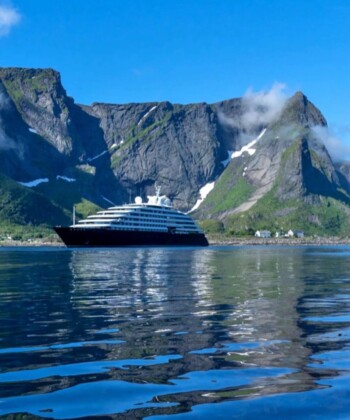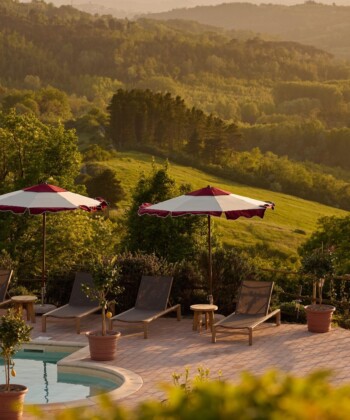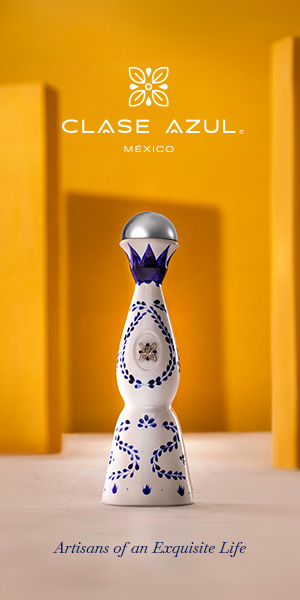The drive from Tromsø to Olderdalen, in a U-shaped valley in northern Norway’s Lyngen Alps, is long, winding and not a little disconcerting, especially given the only rental car available to us is a Yeti, a misleadingly rugged name for a tiny, tinny vehicle not entirely up to the task of handling Arctic roads, even paved ones. When we set off before dawn, the hotel clerk warns us to beware of avalanches, and he isn’t just having fun with the Americans: Only yesterday, he reports, a German was killed by falling snow on the very roads we plan to travel. Then, amiably, if a little weakly: “You’ll be fine. Your reflexes are good?”
As far as scenic drives go, though, this one—56 miles for which we are told to budget three hours—is hard to top, even without snow tires or guardrails. Although it is postcard-beautiful, this particular stretch of Norwegian coast, about 1,800 miles north of Oslo, remains almost entirely untouched by tourism. For one thing, Norway—the world’s 11th largest exporter of oil—doesn’t exactly need the cash. And so there are views without houses, or hotels, hoarding them; miles of glassy fjords and looming glaciers; no meaningful sign of human life beyond the occasional boat or wooden rack of cod laid out to dry. It’s frame after frame of nature at its most arresting, as confirmed by a passenger-seat photographer who insists on climbing out of the Yeti every 100 yards. It’s fine: There is no real rush; no one here to answer to.
We’ve come to Norway to see the Northern Lights, those mythical curtains of color that streak the coldest, darkest night skies, caused by the collision of gas particles between Earth and the sun. Every decade or so, tourists flood aurora-viewing hot-spots for a glimpse of the lights at their brightest and most frequent; peaks like the one happening now last for a few years. One night, as we sit on a cliff 90 minutes from Tromsø staring expectantly, though not impatiently, out at the Norwegian Sea, Halvar Ludvigsen, whose family has owned this land for nearly two centuries, tells me this year’s lights have been bright enough to wake him: flashes of red and green through his bedroom window. “You never give up,” he says of the waiting. “Just when you think it won’t happen, two minutes go by and you get the show of your life.” Half an hour later, nature makes good on his promise, with a 20-minute display of gray and green waves dancing through the clear midnight sky.
With an airport offering daily flights from Oslo, Tromsø is Norway’s most popular destination for Northern Lights chasers, and it’s full of packaged-tour buses and the selfie-stick-wielding tourists who ride them. There are some very good guides here, many of whom will take you as far as Finland in pursuit of the evening’s best lights, but you could also choose to head directly to one of those more thinly populated areas and let the lights come to you. Which brings us back to the Yeti: Our destination in Olderdalen is Lyngen Lodge, an eight-room fjordside hotel with a back deck built for staring at the sky. Owner Graham Austick was leading chartered off-piste ski tours through the Lyngen Alps when he happened upon the land; he built the lodge to offer guests access to the unadulterated Norwegian wilderness, with the comfort of returning to high-thread-count sheets, outdoor jacuzzis and a refined food and wine program (currently under the direction of a Frenchman named Vincent). Most who visit the lodge for Northern Lights spend their days adventuring lite: dogsledding, whale watching, snowshoeing, fishing. By mid-March, when the lights begin to taper, the lodge opens up to more hardcore thrill seekers who come to ski untracked snow right down to the beach.
There’s a chancy social aspect to any small lodge setting, of course, and here the potential pitfalls are rendered even more apparent by the over-the-top peacefulness of the surroundings. By the end of dinner, the English are arguing with the French, the Austrians have stopped speaking entirely, and the Americans have been reminded of our status as such so many times we’ve lost count. The Swiss: not always neutral. Communal dining with people you’ve just met is fun, unless it isn’t, and it’s easy to fantasize about returning when all eight rooms could be filled with people of your choosing (which is possible; the lodge does private and small-group bookings). The setting and the Thai-inspired dinner of Arctic cod pulled from the fjord that morning—and a few glasses of wine—help diffuse most of the tension, but we’re glad when we’re able to bid the Europeans so long and head to our comfortable fjord-front hut down the road, where we’re treated to hours of lights and zero political commentary.
Olderdalen seemed plenty remote. But the next morning, as our plane descends into Longyearbyen, about 600 miles from the North Pole, we understand we hardly knew the meaning of the word. Settled in the early 1900s by a coal-seeking American, Longyearbyen is the main town of the Svalbard archipelago, whose year-round population of about 2,500 is sustained by mining, tourism and science and otherwise attracts, in the words of one local, “writers, explorers, photographers and alcoholics.” Svalbard is also home to the Global Seed Vault, which safe harbors seeds from more than 4,000 plants from around the world, including all the essential food crops.
The cold isn’t as shocking as you might expect—the temperature on Svalbard averages about 25 degrees Fahrenheit. The bigger issue is the polar darkness, which lasts almost four full months. By early March, the light is a pretty predawn blue that grows brighter each day, but the sun remains hidden below the horizon. Timon Brüggemann, a 23-year-old German who leads us dogsledding and ice-caving, tells us the fear of isolation encourages people to be especially social during the darkness, but that it still results in a community of transients. Those who do stick around, meanwhile, seem to like to foster a Lost vibe. Viggo, a retired army officer who has been leading taxicab tours here since 2005, tells us that Svalbard “is a place where you don’t die of age, you die of tragedy,” which is only slight hyperbole. Many residents sleep with their guns, in case a polar bear barges in during the night. Still, says Viggo, Longyearbyen is a “perfect place to raise children,” because there is plenty of money, plenty of nature and, polar bear breaking and entering notwithstanding, no crime.
Visitors come to Svalbard for the nature, as well as for rugged but manageable outdoor adventure—polar bear safaris, glacier walks, dogsled trips and other explorations of the Arctic wilderness, and outfitters like the one we used, Epic Road, can customize itineraries according to interests and ability. Most residents get around by snowmobile, or “snow scooter,” and on our first day, four of us get a brief tutorial before gearing up in giant snowsuits and embarking on a 120-mile journey to the island’s east coast and back in search of polar bears and other wildlife: reindeer, foxes and birds. As I cruise over flat permafrost and through barren valleys of ice, I smugly think I must have a natural talent for snowmobiling: It’s easier than I thought. Half an hour later, I less smugly tip my scooter while maneuvering some “terrain.”
But we are Arctic explorers! And, without any verifiably broken ribs, I’m not given the option of turning back anyway, which is sort of like when I fell off a horse in Patagonia. The next 100 miles are thrilling and terrifying, an emotional and physical love-hate roller coaster, as we travel up and over glaciers, through a blizzard, past giant holes in the earth (“I knew that was there,” assures our guide, Vegard, half-convincingly) and across ice that in warmer months is the Arctic Ocean. Vegard rides with a rifle on his back, because although the goal is to see polar bears, the goal is to see them at a distance. The bears don’t necessarily share those goals, however, and they can run very fast.
While the outing is probably more intense than I would have signed up for had I fully paid attention to what would be expected of me (i.e., some experience riding a snowmobile), that’s also what made it so rewarding. Kicking back on your scooter to stare into the Arctic Ocean from atop a glacier, a pouch of rehydrated potato stew in hand, isn’t an experience or a feeling you’re likely to ever forget.
That night, dinner is not powdery potato stew but multiple courses at Huset, the island’s five-star (by any measure) restaurant in a building that has served, over its many years standing, as a post office, a school, a hospital and a church. The wine cellar—improbably, one of northern Europe’s largest, with about 20,000 bottles and best, with a “two wine glass” rating from Wine Spectator—was once a choir practice room. Although Svalbard has no arable land, most of Huset’s menu comes from local sources: Arctic char and snow crab, greenhouse-grown produce, sea vegetables and, of course, reindeer, which depending on who you ask, tastes like lamb or beef or the feeling you had when you found out Santa wasn’t real. The dinner and the restaurant do a very good job of emphasizing a point that by now is obvious: Svalbard is a place of extremes, and far warmer than its icy exterior might have you believe. Even within the refined setting of Huset, there is a cabaret performance going on upstairs, where after dinner we run into Vegard, who greets us as if we’re old friends.
Two days later, the sun returns to Longyearbyen, just like that.
NEXT: Contact information and more recommendations on hotels, restaurants and activities in northern Norway




